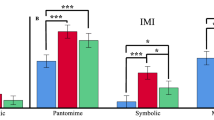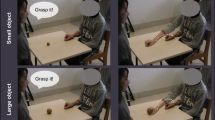Abstract
Previous studies measuring praxis abilities in young autistic children have only used praxis measures that were not optimised for autistic individuals. Hence, we used the FAB-R to measure praxis skills in autistic (n = 38) and typically developing (TD) children (n = 38) aged between four and 10 years. Praxis abilities were generally not different between autistic and TD children. However, total dyspraxia and errors during verbal command and tool use were impaired in autistic children from a specialist autistic school (SAS). In contrast, autistic participants from the GC typically did not differ in praxis performance compared to controls. Hence, praxis abilities significantly vary between autistic younger children. Exploring mediating influences of such variability is imperative.
Similar content being viewed by others
References
Abu-Dahab, S. M., Skidmore, E. R., Holm, M. B., Rogers, J. C., & Minshew, N. J. (2013). Motor and tactile-perceptual skill differences between individuals with high-functioning autism and typically developing individuals ages 5–21. Journal of Autism and Developmental Disorders, 43(10), 2241–2248.
American Psychiatric Association. (2013). Diagnostic and statistical manual of mental disorders (5th ed.). Washington, DC: American Psychiatric Association.
Ayers, A. J. (1989). Sensory Integration and praxis tests (SIPT). Los Angels: Western Psychological Services.
Becker-Weidman, A. (2009). Effects of early maltreatment on development: A descriptive study using the Vineland Adaptive Behavior Scales-II. Child Welfare, 88(2), 137.
Bodison, S. C. (2015). Developmental dyspraxia and the play skills of children with autism. American Journal of Occupational Therapy, 69(5), 6905185060p6905185061–6905185060p6905185066.
Carper, R. A., Moses, P., Tigue, Z. D., & Courchesne, E. (2002). Cerebral lobes in autism: early hyperplasia and abnormal age effects. Neuroimage, 16(4), 1038–1051.
Casartelli, L., Molteni, M., & Ronconi, L. (2016). So close yet so far: Motor anomalies impacting on social functioning in autism spectrum disorder. Neuroscience and Biobehavioral Reviews, 63, 98–105.
Denckla, M. B. (1985). Revised neurological examination and subtle signs. Psychopharmacology Bulletin, 21, 773–779.
Dewey, D., Cantell, M., & Crawford, S. G. (2007). Motor and gestural performance in children with autism spectrum disorders, developmental coordination disorder, and/or attention deficit hyperactivity disorder. Journal of the International Neuropsychological Society, 13(2), 246–256.
Dowell, L. R., Mahone, E. M., & Mostofsky, S. H. (2009). Associations of postural knowledge and basic motor skill with dyspraxia in autism: implication for abnormalities in distributed connectivity and motor learning. Neuropsychology, 23(5), 563.
Dziuk, M., Larson, J., Apostu, A., Mahone, E., Denckla, M., & Mostofsky, S. (2007). Dyspraxia in autism: association with motor, social, and communicative deficits. Developmental Medicine and Child Neurology, 49(10), 734–739.
Ewen, J. B., Lakshmanan, B. M., Pillai, A. S., McAuliffe, D., Nettles, C., Hallett, M., et al. (2016). Decreased modulation of EEG oscillations in high-functioning autism during a motor control task. Frontiers in Human Neuroscience, 10, 198.
Field, A. (2013). Discovering statistics using IBM SPSS statistics. London: Sage.
Gizzonio, V., Avanzini, P., Campi, C., Orivoli, S., Piccolo, B., Cantalupo, G., et al. (2015). Failure in pantomime action execution correlates with the severity of social behavior deficits in children with autism: a praxis study. Journal of Autism and Developmental Disorders, 45(10), 3085–3097.
Gowen, E., & Hamilton, A. (2013). Motor abilities in autism: A review using a computational context. Journal of Autism and Developmental Disorders, 43(2), 323–344.
Green, D., Charman, T., Pickles, A., Chandler, S., Loucas, T., Simonoff, E., et al. (2009). Impairment in movement skills of children with autistic spectrum disorders. Developmental Medicine and Child Neurology, 51(4), 311–316.
Griffin, C., Lombardo, M. V., & Auyeung, B. (2016). Alexithymia in children with and without autism spectrum disorders. Autism Research, 9(7), 773–780.
Hamilton, A. F. D. C., Brindley, R. M., & Frith, U. (2007). Imitation and action understanding in autistic spectrum disorders: how valid is the hypothesis of a deficit in the mirror neuron system? Neuropsychologia, 45(8), 1859–1868.
Haswell, C. C., Izawa, J., Dowell, L. R., Mostofsky, S. H., & Shadmehr, R. (2009). Representation of internal models of action in the autistic brain. Nature Neuroscience, 12(8), 970.
Hickok, G. (2009). Eight problems for the mirror neuron theory of action understanding in monkeys and humans. Journal of Cognitive Neuroscience, 21(7), 1229–1243.
Holden, E. W., Tarnowski, K. J., & Prinz, R. J. (1982). Reliability of neurological soft signs in children: Reevaluation of the PANESS. Journal of Abnormal Child Psychology, 10(2), 163–172.
Jansiewicz, E. M., Goldberg, M. C., Newschaffer, C. J., Denckla, M. B., Landa, R., & Mostofsky, S. H. (2006). Motor signs distinguish children with high functioning autism and Asperger’s syndrome from controls. Journal of Autism and Developmental Disorders, 36(5), 613–621.
Klin, A., Saulnier, C. A., Sparrow, S. S., Cicchetti, D. V., Volkmar, F. R., & Lord, C. (2007). Social and communication abilities and disabilities in higher functioning individuals with autism spectrum disorders: The Vineland and the ADOS. Journal of Autism and Developmental Disorders, 37(4), 748–759.
MacDonald, M., Lord, C., & Ulrich, D. A. (2014). Motor skills and calibrated autism severity in young children with autism spectrum disorder. Adapted physical activity quarterly, 31(2), 95–105.
MacNeil, L. K., & Mostofsky, S. H. (2012). Specificity of dyspraxia in children with autism. Neuropsychology, 26(2), 165.
Mayes, S. D., Calhoun, S. L., Murray, M. J., Morrow, J. D., Yurich, K. K., Mahr, F., ··· Petersen, C. (2009). Comparison of scores on the checklist for autism spectrum disorder, childhood autism rating scale, and Gilliam Asperger’s disorder scale for children with low functioning autism, high functioning autism, Asperger’s disorder, ADHD, and typical development. Journal of Autism and Developmental Disorders, 39(12), 1682–1693.
Miller, M., Chukoskie, L., Zinni, M., Townsend, J., & Trauner, D. (2014). Dyspraxia, motor function and visual–motor integration in autism. Behavioural Brain Research, 269, 95–102.
Mostofsky, S. H., Dubey, P., Jerath, V. K., Jansiewicz, E. M., Goldberg, M. C., & Denckla, M. B. (2006). Developmental dyspraxia is not limited to imitation in children with autism spectrum disorders. Journal of the International Neuropsychological Society, 12(3), 314–326.
Oberman, L. M., Hubbard, E. M., McCleery, J. P., Altschuler, E. L., Ramachandran, V. S., & Pineda, J. A. (2005). EEG evidence for mirror neuron dysfunction in autism spectrum disorders. Cognitive Brain Research, 24(2), 190–198.
Ozonoff, S., Young, G. S., Goldring, S., Greiss-Hess, L., Herrera, A. M., Steele, J., et al. (2008). Gross motor development, movement abnormalities, and early identification of autism. Journal of Autism and Developmental Disorders, 38(4), 644–656.
Perkins, T., Stokes, M., McGillivray, J., & Bittar, R. (2010). Mirror neuron dysfunction in autism spectrum disorders. Journal of Clinical Neuroscience, 17(10), 1239–1243.
Puig, O., Calvo, R., Rosa, M., de la Serna, E., Lera-Miguel, S., Sánchez-Gistau, V., et al. (2013). Verbal memory and IQ predict adaptive behavior in children and adolescents with high-functioning autism spectrum disorders. Journal of Intellectual Disability-Diagnosis and Treatment, 1(1), 22–27.
Qiu, A., Adler, M., Crocetti, D., Miller, M. I., & Mostofsky, S. H. (2010). Basal ganglia shapes predict social, communication, and motor dysfunctions in boys with autism spectrum disorder. Journal of the American Academy of Child and Adolescent Psychiatry, 49(6), 539–551.e534. https://doi.org/10.1097/00004583-201006000-00003.
Rinehart, N. J., Bradshaw, J. L., Brereton, A. V., & Tonge, B. J. (2001). Movement preparation in high-functioning autism and Asperger disorder: a serial choice reaction time task involving motor reprogramming. Journal of Autism and Developmental Disorders, 31(1), 79–88.
Rizzolatti, G., & Craighero, L. (2004). The mirror-neuron system. Annual Review of Neuroscience, 27, 169–192.
Roley, S. S., Mailloux, Z., Parham, L. D., Schaaf, R. C., Lane, C. J., & Cermak, S. (2015). Sensory integration and praxis patterns in children with autism. American Journal of Occupational Therapy, 69(1), 6901220010p6901220011–6901220010p6901220018.
Rothi, L. J. G., Raymer, A. M., & Heilman, K. M. (1997). Limb praxis assessment. In L. J. G. Rothi (Ed.), Apraxia: The neuropsychology of action (pp. 61–73). Boca Raton: CRC Press.
Smits-Engelsman, B., & Hill, E. L. (2012). The relationship between motor coordination and intelligence across the IQ range. Pediatrics. https://doi.org/10.1542/peds.2011-3712.
Sparrow, S. S., Cicchetti, D. V., & Balla, D. (2005). Vineland adaptive behavior scales: (Vineland II), survey interview form/caregiver rating form. Livonia, MN: Pearson Assessments.
Sporns, O., & Betzel, R. F. (2016). Modular brain networks. Annual Review of Psychology, 67, 613–640.
Vitiello, B., Ricciuti, A. J., Stoff, D. M., Behar, D., & Denckla, M. B. (1989). Reliability of subtle (soft) neurological signs in children. Journal of the American Academy of Child and Adolescent Psychiatry, 28(5), 749–753.
Wadsworth, H. M., Maximo, J. O., Donnelly, R. J., & Kana, R. K. (2018). Action simulation and mirroring in children with autism spectrum disorders. Behavioural Brain Research, 341, 1–8.
Williams, J. H., Whiten, A., Suddendorf, T., & Perrett, D. I. (2001). Imitation, mirror neurons and autism. Neuroscience and Biobehavioral Reviews, 25(4), 287–295.
Yang, J., & Hofmann, J. (2016). Action observation and imitation in autism spectrum disorders: An ALE meta-analysis of fMRI studies. Brain Imaging and Behavior, 10(4), 960–969.
Acknowledgments
We would like to thank the children, and parents and guardians who agreed to participate in this research study. Also, thank you to Nicholas Taylor, Zoe De Jong, Catherine Crucitti, Emma McAllister and Amber Hopper for assisting in data collection. Lastly, thank you to the representatives of the Autism specialist school for allowing us to recruit and test participants within your facilities. The authors have no conflict of interest nor received any grants in regards to this manuscript.
Author information
Authors and Affiliations
Contributions
All authors contributed to the design, instrumentation and operationalisation, analysis, and interpretation of the data, as well as the drafting of the paper, with the primary author having recruited the participants and collected the data.
Corresponding author
Ethics declarations
Conflict of interest
The authors declare that they have no conflict of interest.
Ethical Approval
All procedures performed in studies involving human participants were in accordance with the ethical standards of the institutional and/or national research committee and with the 1964 Helsinki declaration and its later amendments or comparable ethical standards.
Additional information
Publisher's Note
Springer Nature remains neutral with regard to jurisdictional claims in published maps and institutional affiliations.
Rights and permissions
About this article
Cite this article
Crucitti, J., Hyde, C. & Stokes, M.A. Hammering that Nail: Varied Praxis Motor Skills in Younger Autistic Children. J Autism Dev Disord 50, 3253–3262 (2020). https://doi.org/10.1007/s10803-019-04136-4
Published:
Issue Date:
DOI: https://doi.org/10.1007/s10803-019-04136-4




